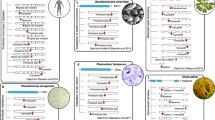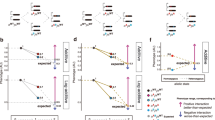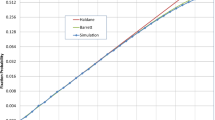Abstract
The theory of population genetics leads to the expectation that in very large populations the frequencies of recessive lethal mutations are close to the square root of the mutation rate, corresponding to mutation-selection balance. There are numerous examples where the frequencies of such alleles are orders of magnitude larger than this result. In this work we theoretically investigate the role of temporal fluctuations in the heterozygous effect (h) for lethal mutations in very large populations. For fluctuations of h, around a mean value of \(\bar{h}\), we find a biased outcome that is described by an effective dominance coefficient, heff, that is generally less than the mean dominance coefficient, i.e., \({h}_{{\rm{eff}}}\, < \, \bar{h}\). In the case where the mean dominance coefficient is zero, the effective dominance coefficient is negative: heff < 0, corresponding to the lethal allele behaving as though overdominant and having an elevated mean frequency. This case plausibly explains mean allele frequencies that are an order of magnitude larger than the equilibrium frequency of a recessive allele with a constant dominance coefficient. Our analysis may be relevant to explaining lethal disorders with anomalously high frequencies, such as cystic fibrosis and Tay-Sachs, and may open the door to further investigations into the statistics of fluctuations of the heterozygous effect.
This is a preview of subscription content, access via your institution
Access options
Subscribe to this journal
Receive 12 print issues and online access
$259.00 per year
only $21.58 per issue
Buy this article
- Purchase on Springer Link
- Instant access to full article PDF
Prices may be subject to local taxes which are calculated during checkout


Similar content being viewed by others
Notes
Temporal homogeneity means the correlation of h (t1) and h (t2) only depends on t1 and t2 in the combination t1 − t2.
The approach we adopt, that the correlation time is non-zero but we treat as being negligible, plays an important role in the way the noise is treated (see Part D of the “Supplementary Material”).
If h(t) is correlated over relatively long times, then it ceases to behave like random fluctuations and is more plausibly represented as a known function of time.
The form of heff in Eq. (15) has a wider applicability than just fluctuating h. For the alternative selection scheme waa = 0, waA = 1 − ζ and wAA = 1 + η, where ∣ζ∣ and ∣η∣ are small, an approximation for the force is F(x) ≃ u − (η + ζ)x − x2 (see Eq. (B2) of Part B of the “Supplementary Material”). When there are fluctuations in the fitnesses of the non-lethal genotypes, i.e., in ζ and η, all results will be equivalent to just h fluctuating providing η(t) + ζ(t) has the same statistical properties as those we have adopted for h(t).
References
Hedrick PW. Heterozygote advantage: the effect of artificial selection in livestock and pets. J Heredity. 2015;106:141–54.
Kong A, et al. Rate of de novo mutations and the importance of father’s age to disease risk. Nature. 2012;488:471–5.
Hedrick PW. Lethals in finite populations. Evolution. 1984;56:654–7.
Myrianthopoulos NC, Aronson SM. Population dynamics of Tay-Sachs disease. I. Reproductive fitness and selection. Am J Hum Genet. 1966;18:313–27.
Farrell PM. The prevalence of cystic fibrosis in the European Union. J Cyst Fibros 2008;7:450–3.
World Health Organization, Sickle-Cell Anaemia. Fifty-Ninth World Health Assembly, A59/9 (2006).
Genton B, al-Yaman F, Mgone CS, Alexander N, Paniu MM, Alpers MP, et al. Ovalocytosis and cerebral malaria. Nature. 1995;378:564–5.
Hedrick PW. What is the evidence for heterozygote advantage selection? Trends Ecol Evolution. 2012;27:698–4.
Arzuza-Ortega L, Polo A, Perez-Tatis G, Lopez-Garcia H, Parra E, Pardo-Herrera LC, et al. Fatal sickle cell disease and Zika virus infection in girl from Colombia. Emerg Infect Dis. 2015;22:925–7.
Spyropoulos B. Tay-Sachs carriers and tuberculosis resistance. Nature. 1988;25:666.
Rodman DM, Zamudio S. The cystic fibrosis heterozygote–advantage in surviving cholera? Med Hypotheses. 1991;36:253–8.
Poolman EM, Galvani AP. Evaluating candidate agents of selective pressure for cystic fibrosis. J R Soc Interface. 2007;4:91–8.
Bell G. Fluctuating selection: the perpetual renewal of adaptation in variable environments. Philos Trans R Soc Lond B Biol Sci. 2010;365:87–97.
Glaziou P, Floyd K, Raviglione M. Trends in tuberculosis in the UK. Thorax. 2018;73:702–3.
Amorim CEG, Gao Z, Baker Z, Diesel JF, Simons YB, et al. The population genetics of human disease: The case of recessive, lethal mutations. PLoS Genet. 2017;13:e1006915.
Waxman D, Overall ADJ. Influence of dominance and drift on lethal mutations in human populations. Front Genet. 2020;11:267.
Nei M. Heterozygous effects and frequency changes of lethal genes in populations. Genetics. 1969;63:669–80.
Gossmann TI, Waxman D, Eyre-Walker A. Fluctuating selection models and McDonald-Kreitman type analyses. PloS One. 2014;9:e84540.
Waxman D. A unified treatment of the probability of fixation when population size and the strength of selection change over time. Genetics. 2011;188:907–13.
Tuckwell HC. Elementary applications of probability theory, 2nd ed. Chapman and Hall, London (1995).
Haigh J. Probability models. Springer, London (2002). https://www.amazon.co.uk/Handbook-Mathematical-Functions-Paperback-CD-ROM/dp/0521140633.
Olver FWJ, Lozier DW, Boisvert RF, Clark CW (eds.) NIST Handbook of mathematical functions. Cambridge University Press, Cambridge (2010).
Dawson KP, Frossard PM. A hypothesis regarding the origin and spread of the cystic fibrosis mutation ΔF508. QJM: Int J Med. 2000;93:313–5.
Acknowledgements
We thank Professor Akihiro Fujimoto and two anonymous reviewers for comments which have helped us to significantly improve this manuscript.
Author information
Authors and Affiliations
Corresponding author
Ethics declarations
Competing interests
The authors declare that they have no conflict of interest.
Additional information
Publisher’s note Springer Nature remains neutral with regard to jurisdictional claims in published maps and institutional affiliations.
Supplementary information
Rights and permissions
About this article
Cite this article
Overall, A.D.J., Waxman, D. Lethal mutations with fluctuating heterozygous effect: the lethal force of effective dominance. J Hum Genet 65, 1105–1113 (2020). https://doi.org/10.1038/s10038-020-0801-3
Received:
Accepted:
Published:
Issue Date:
DOI: https://doi.org/10.1038/s10038-020-0801-3



